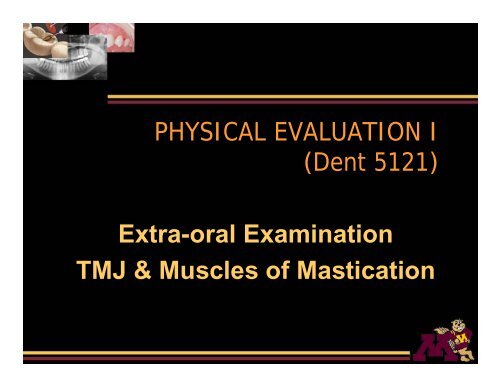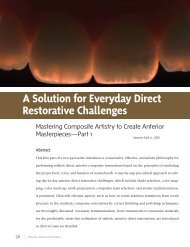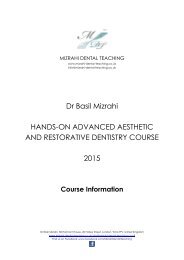18b TMJ
18b TMJ
18b TMJ
Create successful ePaper yourself
Turn your PDF publications into a flip-book with our unique Google optimized e-Paper software.
PHYSICAL EVALUATION I<br />
(Dent 5121)<br />
Extra-oral Examination<br />
<strong>TMJ</strong> & Muscles of Mastication
Lecture Objectives<br />
After today’s lecture, the student will be able to:<br />
Describe the anatomy and function of the<br />
temporomandibular joints and muscles of<br />
mastication.<br />
Describe how to examine the function of the<br />
temporomandibular joints and muscles of<br />
mastication and how to record the findings in the<br />
dental record.<br />
Describe some common abnormal findings and disorders<br />
associated with the temporomandibular joints and<br />
muscles of mastication.
Temporomandibular Joint Anatomy<br />
• Mandibular condyle<br />
• Glenoid fossa and<br />
articular eminence of<br />
temporal bone
Temporomandibular Joint Anatomy<br />
• Articular disc<br />
• Posterior attachment<br />
• Superior head of<br />
lateral pterygoid<br />
muscle<br />
• <strong>TMJ</strong> capsule
Normal <strong>TMJ</strong>
• Temporomandibular Disorders – functional<br />
disturbances of the masticatory system<br />
Muscles of mastication<br />
Temporomandibular joints<br />
Both
Temporomandibular Disorders<br />
• Diagnoses involving the muscles of<br />
mastication<br />
–Myalgia<br />
– Myofascial pain
Temporomandibular Disorders<br />
• Diagnoses involving the temporomandibular<br />
joints<br />
– Disc displacement (with and without reduction)<br />
– Deviation in form<br />
– Capsulitis/arthritis<br />
– Subluxation/dislocation
Screening Questions<br />
• Pain in jaw/temples/ears<br />
• Fatigue/stiffness in jaw<br />
• Difficulty opening<br />
• Locking open/closed<br />
• <strong>TMJ</strong> noise<br />
• Trauma to jaw/face<br />
• Change in occlusion<br />
• Oral habits
• Range of mandibular<br />
motion<br />
–Vertical<br />
• Limitation<br />
• Deviation/deflection<br />
– Lateral<br />
• Limitation<br />
–Protrusion<br />
• Limitation<br />
• Deviation/deflection<br />
Screening Examination<br />
• <strong>TMJ</strong> noise<br />
• Pain to palpation<br />
–<strong>TMJ</strong><br />
– Masticatory muscles<br />
• Occlusion
Active Range of Motion
Active Range of Motion<br />
Normal Active ROM<br />
40-60 mm<br />
Adjusted for vertical overlap<br />
of incisors<br />
Males>Females
Pattern of Opening
Deviation in Opening
Deviation in Opening
• Which <strong>TMJ</strong> is involved?<br />
• What may be happening?<br />
Deviation in Opening
Deflection in Opening
• Which <strong>TMJ</strong> is involved?<br />
• What may be happening?<br />
Deflection in Opening
Lateral Range of Motion
Lateral Range of Motion
Lateral Range of Motion<br />
Normal Lateral ROM<br />
>7 mm<br />
Adjusted for deviation in midlines<br />
Males>Females
Tempormandibular Joint<br />
• Locate the <strong>TMJ</strong> by palpating while patient opens and closes<br />
mouth
Tempormandibular Joint<br />
• Palpate <strong>TMJ</strong> for joint noises
Tempormandibular Joint<br />
• Auscultate <strong>TMJ</strong> noises (not routinely done)
Tempormandibular Joint Sounds
Anterior Disc Displacement<br />
• Anterior disc<br />
displacement with<br />
reduction<br />
• <strong>TMJ</strong> sound:<br />
– Reciprocal click<br />
or<br />
– Reproducible<br />
opening click
Anterior Disc Displacement<br />
• Anterior disc<br />
displacement<br />
without reduction<br />
• <strong>TMJ</strong> sound:<br />
– No click<br />
– Possibly crepitus
Deviation in Form of <strong>TMJ</strong><br />
• Alteration in surface of:<br />
– Articular surface of mandibular condyle<br />
– Articular surface of articular eminence of<br />
temporal bone<br />
– Superior or inferior surface of articular disc<br />
• <strong>TMJ</strong> sound:<br />
– Reproducible opening click<br />
– Reproducible closing click<br />
– Reproducible opening and closing click
Normal <strong>TMJ</strong>
Severe <strong>TMJ</strong> Arthritis
• Arthritis of <strong>TMJ</strong><br />
– Mild articular changes<br />
– Severe articular changes<br />
• <strong>TMJ</strong> sound:<br />
– Fine crepitus<br />
– Coarse crepitus<br />
<strong>TMJ</strong> Arthritis
<strong>TMJ</strong> Subluxation<br />
• Condylar head<br />
moves too far<br />
beyond the articular<br />
eminence<br />
• <strong>TMJ</strong> sound:<br />
– Eminence pop
Palpation of <strong>TMJ</strong><br />
• After mandibular<br />
range of motion<br />
assessment<br />
• Locate <strong>TMJ</strong><br />
• Teeth slightly apart<br />
• Not clenching<br />
• Not opening and<br />
closing
X<br />
X
Muscles of<br />
Mastication
• Origin:<br />
– Temporal fossa<br />
• Insertion:<br />
– Coronoid process,<br />
anterior border of<br />
ramus<br />
• Function:<br />
– Elevates and retracts<br />
mandible, clenches<br />
teeth<br />
Temporalis Muscle
Temporalis Muscle<br />
Anterior, middle and<br />
posterior part of<br />
temporalis muscle
Temporalis Muscle
Temporalis Muscle<br />
• Anterior part of temporalis muscle
Temporalis Muscle<br />
• Middle part of temporalis muscle
Temporalis Muscle<br />
• Posterior part of temporalis muscle
• Origin:<br />
– Superficial portion – anterior<br />
2/3 of lower border of<br />
zygomatic arch<br />
– Deep portion – medial<br />
surface of zygomatic arch<br />
• Insertion:<br />
– Lateral surface of ramus,<br />
coronoid process, and angle<br />
of mandible<br />
• Function:<br />
– Elevates mandible, clenches<br />
teeth<br />
Masseter Muscle
Masseter Muscle<br />
Multiple areas of<br />
masster muscle
Masseter Muscle<br />
• Anterior superior part of masseter muscle
Masseter Muscle<br />
• Posterior inferior part of masseter muscle
Medial Pterygoid Muscle<br />
• Origin:<br />
– Medial surface of lateral<br />
pterygoid plate<br />
• Insertion:<br />
– Posterior and lower part of<br />
medial surface of ramus,<br />
angle of mandible<br />
• Function:<br />
– Elevates, protrudes and<br />
laterotrudes the mandible,<br />
clenches teeth
Medial Pterygoid Muscle
Lateral Pterygoid Muscle<br />
• Origin:<br />
– Superior head – infratemporal<br />
surface of greater wing of<br />
sphenoid bone<br />
– Inferior head – lateral surface<br />
of lateral pterygoid plate<br />
• Insertion:<br />
– Anterior portion of condylar<br />
neck and articular disc<br />
• Function:<br />
– Protrudes and laterotrudes the<br />
mandible, pulls articular disc<br />
forward
Temporomandibular Disorders<br />
• Muscles of Mastication<br />
–Myalgia<br />
• Symptoms<br />
– Pain in localized area of one masticatory muscle<br />
(usually masseter or temporalis)<br />
– Fatigue with chewing<br />
•Signs<br />
– Tender muscles upon palpation<br />
– Sometimes limited active vertical range of mandibular<br />
motion
Temporomandibular Disorders<br />
• Muscles of Mastication<br />
– Myofascial pain<br />
• Symptoms<br />
– Regional pain in area of masseter or temporalis muscles<br />
– Tinnitus, vertigo, toothache, tension-type headache<br />
– Fatigue with chewing<br />
– May have limited mandibular function secondary to pain<br />
• Signs<br />
– Multiple tender areas in several masticatory muscles upon<br />
palpation<br />
– Tender areas may refer pain to other locations in face<br />
– Sometimes limited active vertical range of mandibular<br />
motion
• Temporomandibular joints<br />
Temporomandibular Disorders<br />
– Disc displacement with reduction<br />
• Symptoms<br />
– Clicking or popping noise in <strong>TMJ</strong><br />
– May feel “catching” in <strong>TMJ</strong><br />
•Signs<br />
– Reciprocal click<br />
– May have deviation in active vertical mandibular range of<br />
motion and/or in protrusion<br />
– No restriction in active vertical mandibular range motion
Temporomandibular Disorders<br />
• Temporomandibular joints<br />
– Disc displacement without reduction (Closed<br />
lock)<br />
• Symptoms<br />
– History of clicking or popping noise in <strong>TMJ</strong><br />
– Limited mandibular range of motion<br />
•Signs<br />
– No <strong>TMJ</strong> sounds<br />
– Restriction in active vertical mandibular range motion and<br />
laterotrusion<br />
– May have deflection in active vertical mandibular range of<br />
motion and/or in protrusion
Temporomandibular Disorders<br />
• Temporomandibular joints<br />
– Capsulitis/arthritis<br />
• Symptoms<br />
– Pain in <strong>TMJ</strong> or in front of ear<br />
– Pain exacerbated by jaw function<br />
– May have limited mandibular function secondary to pain<br />
•Signs<br />
– <strong>TMJ</strong> tender to palpation<br />
– <strong>TMJ</strong> pain worsened upon clenching<br />
– Limited active mandibular range of motion, laterotrusion,<br />
protrusion
Temporomandibular Disorders<br />
• Temporomandibular joints<br />
– Subluxation/dislocation (Open lock)<br />
• Symptoms<br />
– Jaw “catches” open when yawning or opening mouth wide (if<br />
gets stuck open then dislocation)<br />
– Pain in <strong>TMJ</strong> when jaw gets stuck<br />
– Loud pop when opening wide<br />
•Signs<br />
– Excessive active mandibular vertical range of motion<br />
– Eminence pop<br />
– Residual tenderness in <strong>TMJ</strong> upon palpation if recent episode
Diagnosis of Temporomandibular<br />
• Temporomandibular Disorders -<br />
– Muscles of Mastication<br />
– Temporomandibular joints<br />
–Both<br />
• <strong>TMJ</strong> arthritis and myofascial pain<br />
• <strong>TMJ</strong> disc displacement with reduction, <strong>TMJ</strong><br />
capsulitis, and myalgia<br />
Disorders
Lecture Objectives<br />
After today’s lecture, the student will be able to:<br />
Describe the anatomy and function of the<br />
temporomandibular joints and muscles of<br />
mastication.<br />
Describe how to examine the function of the<br />
temporomandibular joints and muscles of<br />
mastication and how to record the findings in the<br />
dental record.<br />
Describe some common abnormal findings and disorders<br />
associated with the temporomandibular joints and<br />
muscles of mastication.
Clinical Seminar Sessions<br />
Groups 1&2 Groups 3&4 Groups 5&6 Groups 7&8<br />
3/7/08 3/10/08 3/12/08 3/14/08<br />
10:10-12:05 3:35-5:30 3:35-5:30 10:10-12:05<br />
8 th Floor South Clinic<br />
Cubicles 33-46<br />
Wear short sleeved shirt or scrub<br />
top and bring your name tag!<br />
Bring a black/blue ink pen.




